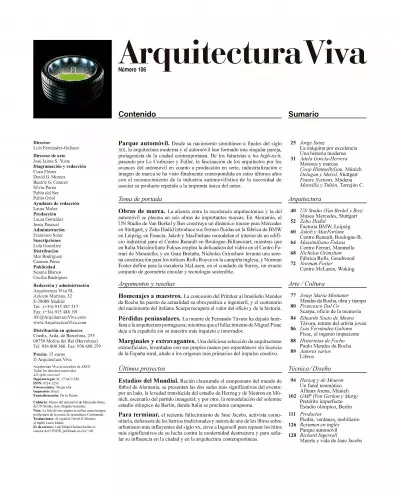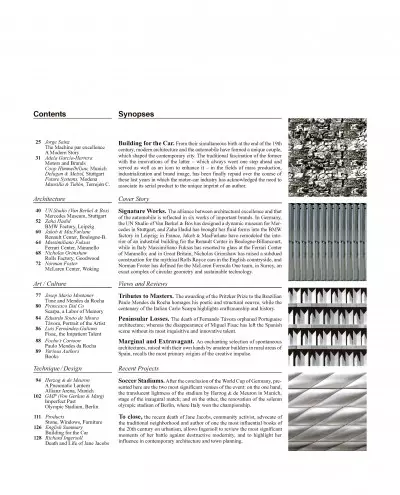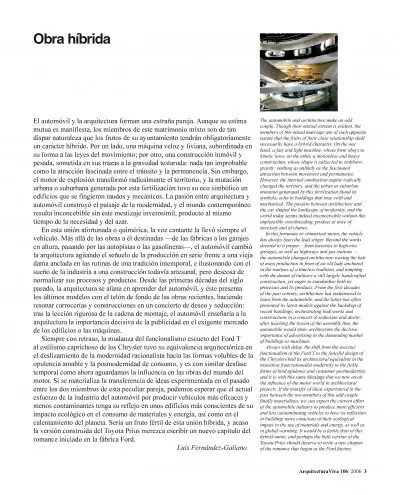Synopses
Building for the Car. From their simultaneous birth at the end of the 19th century, modern architecture and the automobile have formed a unique couple, which shaped the contemporary city. The traditional fascination of the former with the innovations of the latter – which always went one step ahead and
served as well as an icon to enhance it – in the fields of mass production, industrialization and brand image, has been finally repaid over the course of these last years in which the motor-car industry has acknowledged the need to associate its serial product to the unique imprint of an author.
Contents
Jorge Sainz
The Machine par excellence
A Modern Story
Adela García-Herrera
Motors and Brands
Coop Himmelb(l)au, Munich
Delugan & Meissl, Stuttgart
Future Systems, Modena
Mansilla & Tuñón, Torrejón C.
Cover Story
Signature Works. The alliance between architectural excellence and that of the automobile is reflected in six works of important brands. In Germany, the UN Studio of Van Berkel & Bos has designed a dynamic museum for Mercedes in Stuttgart, and Zaha Hadid has brought her fluid forms into the BMW factory in Leipzig; in France, Jakob & MacFarlane have remodeled the interior of an industrial building for the Renault Center in Boulogne-Billancourt, while in Italy Massimiliano Fuksas has resorted to glass at the Ferrari Center of Maranello; and in Great Britain, Nicholas Grimshaw has raised a subdued construction for the mythical Rolls Royce cars in the English countryside, and Norman Foster has defined for the McLaren Formula One team, in Surrey, an exact complex of circular geometry and sustainable technology.
Architecture
UN Studio (Van Berkel & Bos)
Mercedes Museum, Stuttgart
Zaha Hadid
BMW Factory, Leipzig
Jakob & MacFarlane
Renault Center, Boulogne-B.
Massimiliano Fuksas
Ferrari Center, Maranello
Nicholas Grimshaw
Rolls Factory, Goodwood
Norman Foster
McLaren Center, Woking
Views and Reviews
Tributes to Masters. The awarding of the Pritzker Prize to the Brazilian Paulo Mendes da Rocha homages his poetic and structural oeuvre, while the centenary of the Italian Carlo Scarpa highlights craftsmanship and history.
Art / Culture
Josep Maria Montaner
Time and Mendes da Rocha
Francesco Dal Co
Scarpa, a Labor of Memory
Peninsular Losses. The death of Fernando Távora orphaned Portuguese architecture; whereas the disappearance of Miguel Fisac has left the Spanish scene without its most inquisitive and innovative talent. Eduardo Souto de Moura
Távora, Portrait of the Artist
Luis Fernández-Galiano
Fisac, the Impatient TalentMarginal and Extravagant. An enchanting selection of spontaneous architectures, raised with their own hands by amateur builders in rural areas of Spain, recalls the most primary origins of the creative impulse. Focho’s Cartoon
Paulo Mendes da Rocha
Various Authors
Books
Recent Projects
Soccer Stadiums. After the conclusion of the World Cup of Germany, presented here are the two most significant venues of the event: on the one hand, the translucent lightness of the stadium by Herzog & de Meuron in Munich, stage of the inaugural match; and on the other, the renovation of the solemn olympic stadium of Berlin, where Italy won the championship.
Technique / Style
Herzog & de Meuron
A Pneumatic Lantern
Allianz Arena, Munich
GMP (Von Gerkan & Marg)
Imperfect Past
Olympic Stadium, Berlin
To close, the recent death of Jane Jacobs, community activist, advocate of the traditional neighborhood and author of one the most influential books of the 20th century on urbanism, allows Ingersoll to review the most significant moments of her battle against destructive modernity, and to highlight her influence in contemporary architecture and town planning. Products
Stone, Windows, Furniture
English Summary
Building for the Car
Richard Ingersoll
Death and Life of Jane Jacobs
Luis Fernández-Galiano
Hybrid work
The automobile and architecture make an odd couple. Though their mutual esteem is evident, the members of this mixed marriage are of such opposite nature that the fruits of their close relationship shall necessarily have a hybrid character. On the one hand, a fast and light machine, whose form obeys to kinetic laws; on the other, a motionless and heavy construction, whose shape is subjected to stubborn gravity: nothing as unlikely as the fascinated attraction between movement and permanence. However, the internal combustion engine radically changed the territory, and the urban or suburban mutation generated by this fertilization found its symbolic echo in buildings that rose swift and mechanical. The passion between architecture and the car shaped the landscape of modernity, and the world today seems indeed inconceivable without this implausible crossbreeding, product at once of necessity and of chance.
In this fortunate or chimerical union, the vehicle has always been the lead singer. Beyond the works devoted to it proper – from factories to high-rise garages, as well as highways and gas stations –, the automobile changed architecture waving the bait of mass production in front of an old lady anchored in the routines of a timeless tradition, and tempting with the dream of industry a still largely handcrafted construction, yet eager to standardize both its processes and its products. From the first decades of the past century, architecture has endeavored to learn from the automobile, and the latter has often presented its latest models against the backdrop of recent buildings, orchestrating bodyworks and constructions in a concert of seduction and desire: after teaching the lesson of the assembly line, the automobile would show architecture the decisive importance of advertising in the demanding market of buildings or machines.
Always with delay, the shift from the succinct functionalism of the Ford T to the fanciful design of the Chryslers had its architectural equivalent in the transition from rationalist modernity to the fickle forms of kind opulence and consumer postmodernity, and it is with this same décalage that we now await the influence of the motor world in architectural projects. If the transfer of ideas experienced in the past between the two members of this odd couple finally materializes, we can expect the current effort of the automobile industry to produce more efficient and less contaminating vehicles to have its reflection in buildings more conscious of their ecological impact in the use of materials and energy, as well as in global warming. It would be a fertile fruit of this hybrid union, and perhaps the built version of the Toyota Prius should deserve to write a new chapter of the romance that began at the Ford factory.








